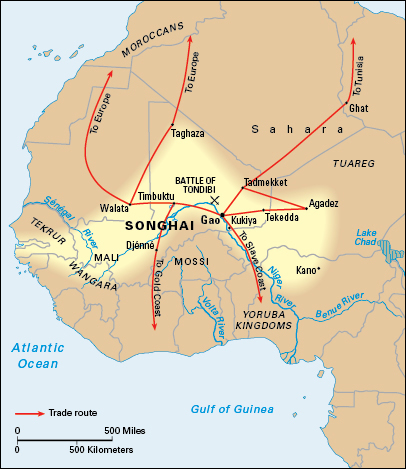Songhai << sawng GY or SAWNG hy >> Empire was a powerful trading state in West Africa that reached its peak during the 1400’s and 1500’s. The empire extended from what is now central Nigeria to the Atlantic coast and included parts of what are now Burkina Faso, Gambia, Guinea, Mali, Mauritania, Niger, and Senegal. Gao, the capital, stood on the Niger River.

Songhai’s roots date back to at least the 700’s. The empire developed from large towns around Kukiya, near the present-day Mali-Niger border. By the 1000’s, Gao had become the center of a kingdom known as Kaw-Kaw. During the 1400’s, Kaw-Kaw expanded to become the vast and rich Songhai Empire. Songhai became powerful chiefly by controlling trade across the Sahara. Most of Songhai’s people farmed, fished, or traded. The traders exchanged gold and other West African products for goods from Europe and southwest Asia.
Two kings, Sunni Ali and Askia Muhammad, strengthened the empire more than any other rulers. Sunni Ali, a great military leader, ruled from 1464 to 1492. His army conquered Timbuktu and Djénné, two large West African trading centers (see Djénné; Timbuktu). Askia Muhammad, also known as Askia I or Askia the Great, became king in 1493. Songhai reached its greatest size under his reign. He encouraged the spread of Islam and governed Songhai according to strict Muslim law. He also expanded trade. Askia’s son deposed him in 1528. The empire’s power declined after a Moroccan army defeated Songhai at the Battle of Tondibi in 1591.
See also Walata.
